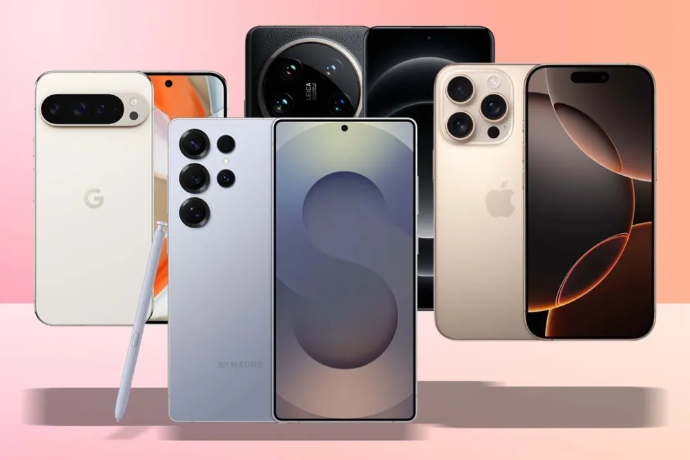AI-Powered Smartphones in 2025: Top Features & Devices

The future of smartphones is here, and it’s AI-powered! Next-gen phones like Google’s Pixel, Samsung’s Galaxy and Apple’s iPhone (shown above) are packing advanced AI features that go beyond mere hardware. In 2025, smartphone trends revolve around on-device AI and generative intelligence – turning your phone into a pocket-sized assistant. Industry analysts forecast that by 2025 roughly 28% of new phones will support generative AI tasks. That means features like smart translation, content summarization and creative image generation will become mainstream. For example, Samsung’s Galaxy S25 Ultra “is packed with generative AI features” (live translation, call transcription, generative editing), Google’s Pixel 9 Pro uses its Gemini AI to summarize calls and even create art from text, and Apple’s iPhone 16 (with its new Apple Intelligence) can do things like a Camera Control button that reverse-searches images and even queries ChatGPT. These are just a few of the 2025 phone AI innovations coming to the Nepal smartphone market and beyond.
Smartphone Trends 2025: AI Takes Center Stage
AI Everywhere: Brands are racing to add generative AI. Canalys predicts about 28% of phones sold in 2025 will have on-device AI capabilities (up from 16% in 2024), with players like Apple, Google, Samsung, Xiaomi and OPPO all integrating AI agents in their devices.
More Power & Memory: AI models are resource-hungry, so phones are getting beefier. For instance, every iPhone 16 model now has 8 GB of RAM (up from 6 GB) and Google’s Pixel 9 series bumped to 12 GB. Apple’s new A18 chip also includes a beefed-up Neural Engine for AI tasks. MediaTek and Qualcomm have likewise built AI accelerators into their 2025 chipsets (e.g. Dimensity 8350 Extreme, Snapdragon’s Dragonwing) to handle on-device AI without draining battery.
Smarter Assistants: Virtual assistants are evolving into AI chatbots. Google’s Pixel 9 phones run Gemini (the Google AI assistant) across the OS, and Apple’s iPhones now include “Apple Intelligence” features. In fact, Apple added a special Camera Control button on iPhone 16 to launch an AI-powered visual search – you can point at a restaurant flyer to pull up its menu or even send the query to ChatGPT for help with homework. Samsung, OPPO and others have similar smart tools (like live voice-call translators and AI chat features) being rolled out.
AI-Enhanced Cameras: Photography is a key battleground. Many phones now use AI to boost photos: scene detection, super-resolution zoom and magic editing. Motorola’s new Edge 60 Pro, for example, offers a “Group Shot 8” mode that snaps 8 frames in one burst and picks the best result for everyone’s eyes-open shot. Google’s Pixel can add you into group photos via AR, remove unwanted objects, or let you “reimagine” a picture from a text prompt. Samsung’s Galaxy AI camera editor can erase reflections, recompose images, or even generate extra frames for smooth slow-motion. These AI camera features make it easier for anyone – even smartphone users in Nepal – to take pro-looking photos.
Key AI Phone Features to Watch in 2025
Here are some exciting AI phone features we expect in 2025:
On-device AI Assistants: Beyond Siri and Google Assistant, phones will have advanced local AI. Expect to see chat-style assistants (like Google’s Gemini) built into the OS for tasks like drafting emails, planning trips, or answering complex questions with one tap.
Intelligent Camera Modes: AI will automatically pick the best camera settings, replace backgrounds, or even add you into a scene. Features like Night Mode, AI Portrait and Super-Resolution Zoom will be standard on flagships – and trickle down to midrange models too. (For example, Xiaomi’s 2024 flagships already boast AI night-scene enhancement to capture more detail in low light.)
Live Translation & Transcript: Real-time language translation for calls and texts will improve. The new Samsung S25/S25 Ultra can translate phone calls in real time, and can transcribe your voicemail into text summaries instantly. Similar tools will appear on other brands, making travel and communication easier.
Proactive Personalization: Phones will use AI to learn your habits. Features like Samsung’s Personal Data Engine customize the UI to how you use your phone. Motorola’s “Next Move” can recognize what you’re viewing (a recipe, email or map) and suggest the next action, like creating a playlist or saving details for later.
Smarter Notifications & Summaries: AI will sift through information for you. New “briefing” widgets (like Samsung’s Now Brief) will auto-summarize sports scores, weather or calendar events on your lock screen. Email and message apps may highlight important points and offer quick replies or emoji reactions generated by AI.
Top AI-Powered Smartphones of 2025
Samsung Galaxy S25 Ultra (2025)
Samsung’s 2025 flagship is a prime example of AI integration. The Galaxy S25 Ultra (6.9″ QHD display, Snapdragon 8 Elite, up to 12 GB RAM) runs Galaxy AI, Samsung’s new software suite. It offers AI Select (a sidebar that lets you highlight any text or image to trigger AI actions), a revamped keyboard with Writing Assist (auto-improve your messages or emails), and on-device tools to summarize long texts or translate languages on the fly. The built-in recorder can transcribe phone calls and summarize them instantly. The camera app includes AI editing (erase reflections or reframe shots) and Instant Slow-mo (automatically adds frames for silky slow-motion). Reviewers note the S25 Ultra is “packed with generative AI features”, though many require a subscription. In short, it’s as much a smart assistant as it is a phone – at a top-tier price.
Google Pixel 9 Pro / XL (2024–25)
Google’s Pixel 9 Pro series already set the tone for AI phones. It introduced Gemini AI everywhere in the UI. Aside from its great cameras (48 MP wide, 50 MP tele, etc.), the Pixel’s real magic is software. Call Notes auto-transcribes and summarizes calls for you. A new Screenshots app can search text inside your screen grabs. The Pixel Studio app can generate images from your prompts or recolor them (one review saw an “iguana tap dancing” created by AI). The Magic Editor lets you reimagine photos (remove objects or change backgrounds). The playful Add Me AR tool can even insert you into group photos seamlessly. Google’s own blog highlights that Pixel phones “now have Gemini, a personal AI assistant” and new camera tricks like Add Me and Super Res Zoom Video. In practice, Pixel 9 Pro is praised as one of the best AI smartphones for 2025, especially if you want the cleanest AI experience on Android.
Apple iPhone 16 Pro (2024)
Apple’s latest flagship introduced Apple Intelligence, its answer to AI assistants. The iPhone 16 Pro (and Pro Max) launched in Sept 2024 and was explicitly “designed around Apple Intelligence”. It runs on the new A18 chip with extra neural cores for generative tasks. Key new AI features include an AI-powered Camera Control button: you can press it to launch “visual intelligence” – essentially a reverse-image search with OCR. For example, pointing at a flyer can pull up event details (you can even add it to Calendar automatically), or at a product to find shopping links. Apple also teamed up with OpenAI: from the Camera Control you can shoot a question over to ChatGPT for answers. On the software side, iOS 18 can rewrite emails, suggest emojis and even create custom emoji avatars via on-device AI. In short, the iPhone 16 Pro packs an AI edge into Apple’s premium device, and it’ll only get smarter as features roll out in 2025.
OnePlus 13 (2025)
OnePlus’s 2025 flagship brings high-end specs at a lower price. Announced at CES 2025, the OnePlus 13 ships with a Snapdragon Elite chip, up to 16 GB RAM, and a huge 6,000 mAh battery. It’s built for endurance (over 24 h per charge) and AI: OnePlus has added “AI editing tricks” to the camera. The triple Hasselblad cameras (all 50 MP) can now do AI Unblur (sharpen a blurry shot), AI Detail Boost (upscale your photo details), and AI Reflection Eraser (remove glare on glass). These tools let you clean up or enhance photos with one tap. OnePlus 13 also includes a Magic Eraser (delete unwanted people/objects), similar to Google’s. Overall, the OnePlus 13 proves you don’t need to pay flagship prices to get AI camera enhancements – it brings cutting-edge AI features down the price ladder.
Motorola Edge 60 Pro (2025)
Motorola’s new Edge 60 Pro takes a unique AI approach. It sports the world’s largest smartphone battery (6,000 mAh with ultra-fast 90W charging) and runs on a MediaTek Dimensity 8350 Extreme chip, which Motorola touts for on-device AI performance. Its camera system is all about AI: the Group Shot 8 mode snaps 8 frames in one second and seamlessly blends them so everyone’s eyes are open in your group photos. Beyond the camera, Motorola’s moto ai 3 software introduces smart prompts: features like “Catch me up”, “Pay attention” and “Remember this” proactively help you stay organized. The Next Move AI can even recognize content on your screen (a recipe, map, etc.) and suggest relevant actions – like saving important details or making a song playlist automatically. In short, the Edge 60 Pro is less known globally but is packed with imaginative AI tools that make it feel like a friendly on-hand assistant.
AI Smartphones in Nepal’s Market
Nepal’s smartphone market is growing fast, and AI is a big part of the story. Local market data (Mar 2025) shows Nepal is dominated by Xiaomi (~25.4%), Samsung (~22.9%) and Apple (~16.6%) – all companies pushing AI features. For example, Xiaomi’s latest flagships (popular in Nepal) include AI-driven camera modes for night photography and portrait shots. Samsung’s Galaxy series (sold by local retailers like Quality Computer) now come with Galaxy AI features like instant translation and smart editing. Even midrange phones from these brands often boast AI camera modes: scene recognition, HDR enhancements and automatic filtering are now table stakes. Nepali buyers often search for “smartphone AI camera Nepal” options, meaning a device that can take great photos with AI help – and many choices exist. Retailers like Quality Computer carry these AI smartphones, from Xiaomi’s Mi series to Samsung’s Galaxy and Apple’s iPhones. As the Nepal smartphone market expands to an estimated $1.3 billion by 2025, shoppers are already enjoying advanced cameras and smart assistants on their devices.
Conclusion
AI is transforming phones in fun and powerful ways. In 2025, the best AI smartphones – from the Samsung S25 Ultra to the Pixel 9 Pro to new entrants like OnePlus 13 and Motorola’s Edge – will bring features that make life easier and more creative. These next-gen phones learn from you, assist you and even entertain you with AI. The Nepal market won’t be left behind: top brands are bringing these innovations here. Whether you want a smartphone with an AI camera that takes pro-quality photos, or a phone that acts like a personal assistant, there’s an AI phone for you.
Feeling inspired? Explore the latest AI-powered phones at Quality Computer, Nepal’s trusted tech retailer, and step into the future of smart devices today!
Sources: Industry reports and tech media (Canalys, IDC, The Verge, TechCrunch, ZDNet, Google’s blog, etc.) on AI phone trends and features.
